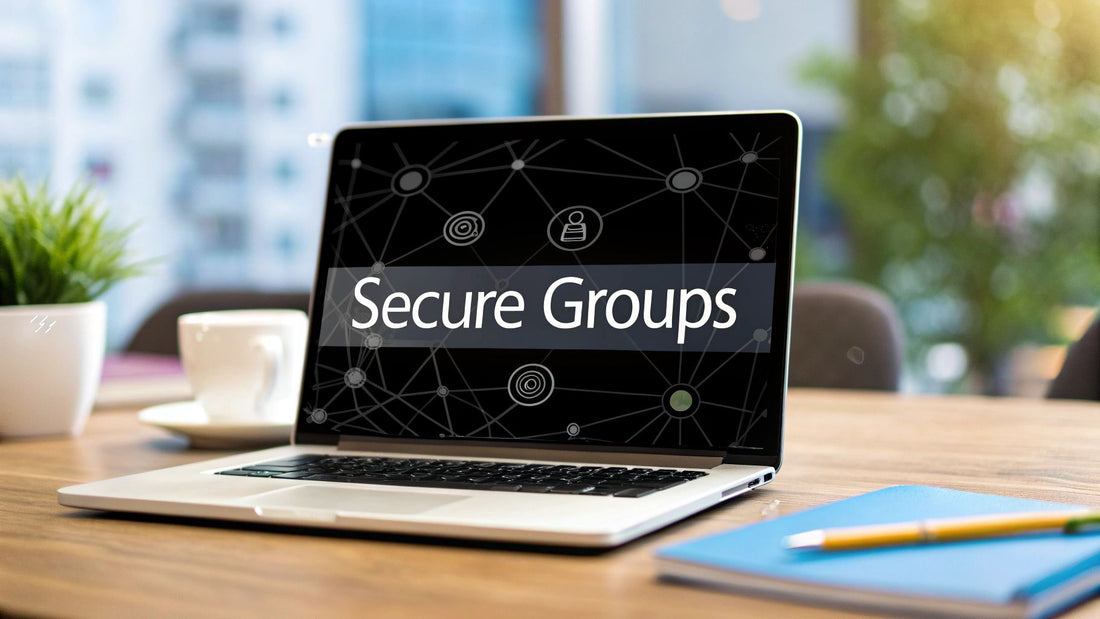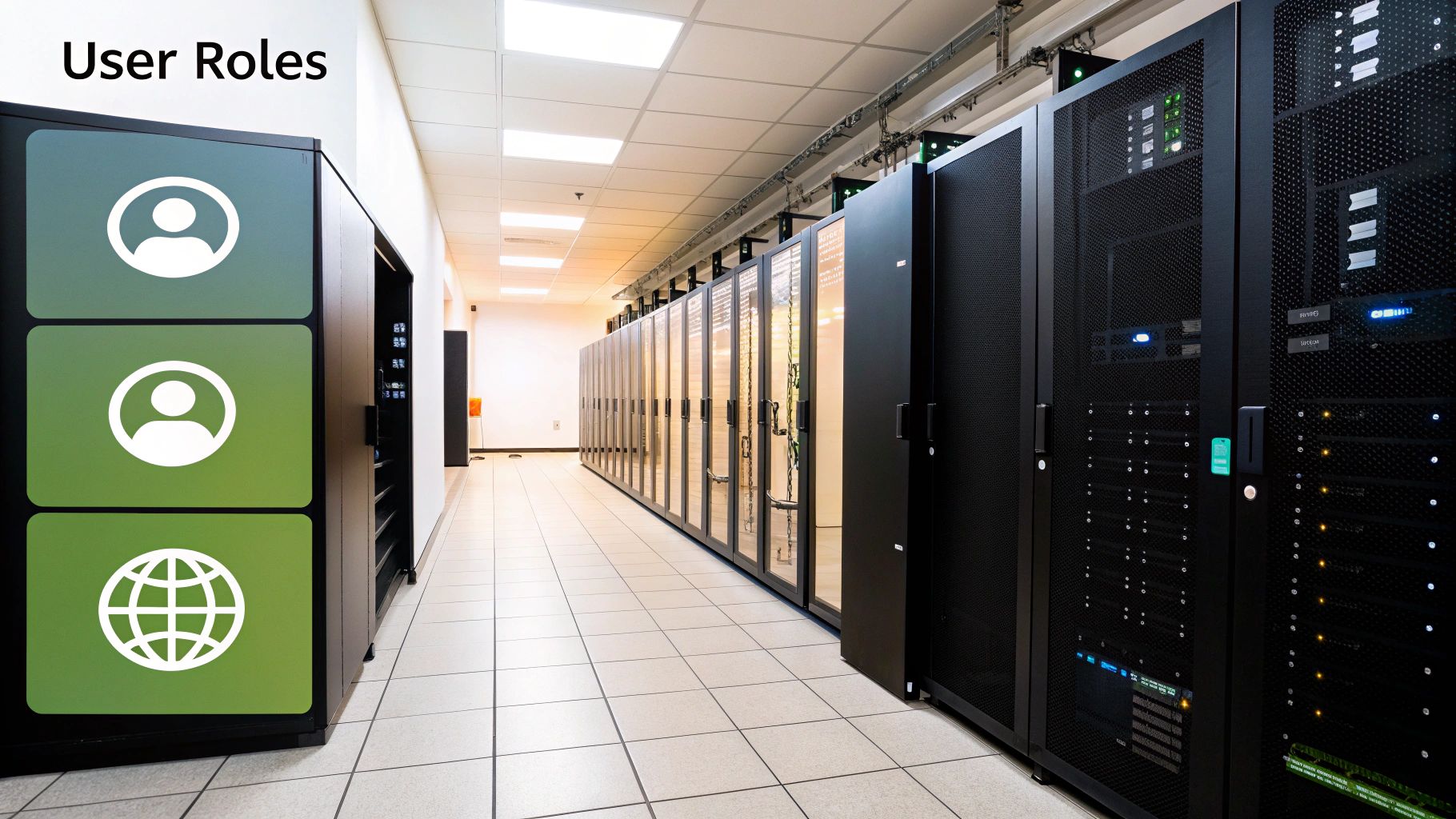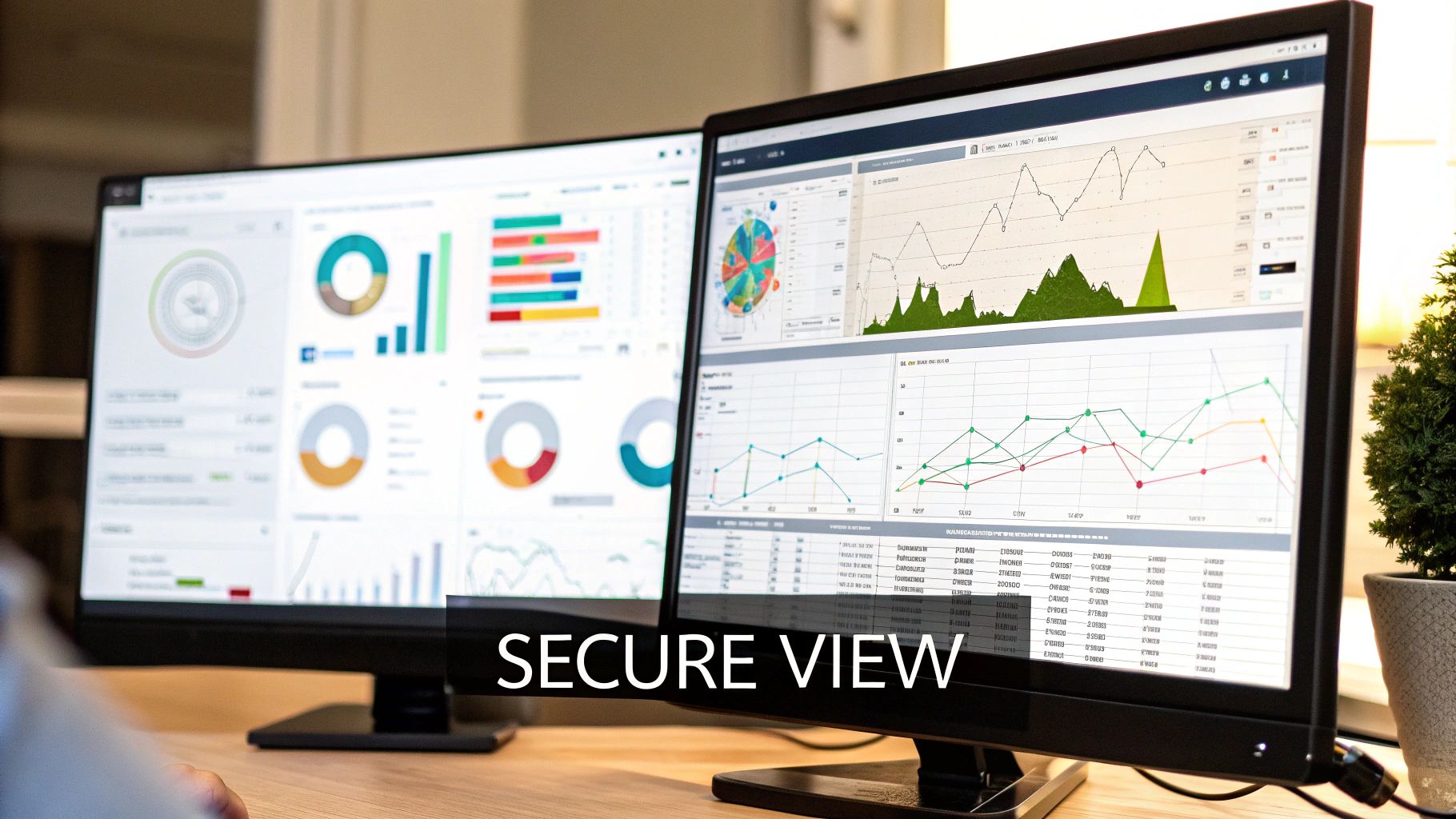
Effective Group Access Control: Secure and Streamline
Share
The Foundations of Modern Group Access Control

Securing digital assets presents a complex challenge in our interconnected world. Group access control offers a vital solution, becoming a cornerstone of modern security strategies. Rather than managing individual user permissions, this approach controls access based on group affiliation. This streamlines administration and significantly strengthens security.
Imagine needing to grant access to a project management tool like Asana. Instead of individually assigning permissions, you can simply add team members to a designated "Project Team" group. This simplifies onboarding and offboarding processes while ensuring consistent access levels across the team. Ultimately, group access control contributes not only to enhanced security but also improved operational efficiency.
Understanding the Core Frameworks
Several frameworks exist within group access control, each having unique advantages and disadvantages. Choosing the right framework for your organization depends on understanding these nuances. The following primary frameworks provide a basis for implementing robust access controls:
-
Role-Based Access Control (RBAC): RBAC assigns permissions based on a user's role within the organization. For instance, a "Marketing Manager" might have access to marketing analytics dashboards, while a "Sales Representative" can access Salesforce.
-
Attribute-Based Access Control (ABAC): ABAC provides a more granular approach. It uses attributes such as department, location, or project involvement to determine access. This allows for more specific permissions, adapting better to complex organizational structures. Access to certain financial data, for example, might be limited to employees in the finance department located at headquarters.
-
Policy-Based Access Control (PBAC): PBAC uses policies, essentially a defined set of rules, to determine access. These policies offer high customizability, incorporating factors like time of day, device used, or even current threat levels. A policy might restrict access to sensitive data from outside the corporate network during non-business hours. You might be interested in: How to master sitemaps.
The Growing Importance of Group Access Control
The increasing global focus on robust security has significantly impacted the access control market. In 2024, the market was valued at approximately USD 10.6 billion. Projections indicate it will reach USD 18.8 billion by 2033, growing at a CAGR of 6.5%. This growth is driven by rising security concerns, greater adoption of cloud-based solutions, and advancements in technologies like AI and biometrics. North America held over 38% of the global market share in 2024, reflecting the substantial demand for advanced security solutions. More detailed statistics can be found here: https://www.imarcgroup.com/access-control-market
Successfully implementing group access control requires a delicate balance between security and usability. While robust security is paramount, it shouldn't hinder employee productivity. Employees need appropriate access to perform their duties efficiently and without unnecessary obstacles. By implementing clearly defined groups and straightforward access policies, organizations can achieve both strong security and smooth operational efficiency. This balance is essential for the long-term success of any access control implementation.
Transforming Security Operations Through Group Access

Many organizations are seeing real benefits from implementing group access control. Well-structured group permissions can streamline workflows and significantly reduce security incidents. This has positive effects on both the bottom line and a company’s overall security.
For example, some businesses have reported a 70% decrease in onboarding time after implementing group access control. This efficiency boost comes from quickly granting new employees access to the resources they need without tedious individual assignments. Plus, group access control reinforces the important principle of least privilege.
This ensures users only have access to the specific information and tools they need for their roles. This, in turn, minimizes potential damage from security breaches or insider threats.
Streamlining Administration and Reducing Incidents
Group access control significantly simplifies user and access management. Instead of managing individual permissions, administrators can assign access based on group affiliation. This reduces administrative overhead and makes sure access levels are consistent across teams. Such consistency minimizes the risk of errors and oversights that could compromise security.
This also means that when an employee changes roles or leaves the company, adjusting access is simple. Updating group memberships automatically updates their access privileges. This prevents lingering access, which is a known security risk. Learn more about access control systems in Building Access Control Systems. This structured approach limits access to sensitive data and systems, therefore also reducing the likelihood of security incidents.
To better illustrate the benefits of this approach, let's take a look at the comparison between group access control and individual user permissions. The following table summarizes the key advantages of each.
Benefits of Group vs. Individual Access Control
| Benefit Category | Group Access Control | Individual Access Control |
|---|---|---|
| Administrative Efficiency | Simplified management, reduced overhead | Requires individual assignments, higher overhead |
| Consistency | Ensures uniform access levels across teams | Potential for inconsistencies and errors |
| Security | Reinforces least privilege, limits access to sensitive data | More difficult to enforce least privilege, higher risk of over-permissioning |
| Scalability | Easily adaptable to changing teams and roles | Can become complex to manage in large organizations |
| Onboarding/Offboarding | Streamlined processes, automated access adjustments | Requires manual intervention, potential for delays |
As the table shows, group access control provides clear advantages in terms of efficiency, consistency, and security, particularly for larger organizations.
Real-World Examples of Enhanced Security
Several organizations have already seen the practical benefits of group access control. Hospitals, for instance, have used group-based permissions to protect patient data, ensuring only authorized medical staff can access sensitive medical information. This strengthens security while streamlining workflows for healthcare providers.
In the financial industry, group access control helps institutions comply with strict data security regulations. By tightly controlling access to financial records, these institutions reduce the risk of data breaches and maintain customer trust. These examples show how group access control enhances security across various industries.
Frameworks For Better Compliance Outcomes
Specific frameworks can help security teams improve compliance and lighten the load on IT departments. Robust group access control systems streamline audit processes and help organizations demonstrate compliance with industry regulations. This proactive approach reduces the risk of costly fines and reputational damage that can come with non-compliance.
By automating access management tasks, IT departments can focus on strategic projects instead of routine administrative duties. This increased efficiency frees up resources and allows for a more agile and responsive IT infrastructure.
Cloud-Based Access Control: Beyond Traditional Boundaries

The move to cloud computing has dramatically changed how organizations handle group access control. Instead of on-premises systems, businesses are now using dynamic cloud platforms to secure distributed resources. This offers increased flexibility and scalability, but presents its own set of challenges.
One primary challenge is integrating cloud-based access control with existing systems. Many organizations use legacy systems that need to integrate with new cloud environments. Data sovereignty requirements add further complexity, often dictating where data is stored geographically. Maintaining consistent policies across these hybrid environments is essential for robust security.
Key Challenges and Solutions in Cloud Access Control
Addressing these challenges requires a strategic, phased approach. Security architects recommend starting with a comprehensive assessment of existing systems and security needs. This includes identifying critical resources and data requiring protection.
For example, a company migrating to a cloud-based email platform (Microsoft 365) must define access levels for different employee groups. This ensures only authorized personnel can access sensitive emails and attachments. Clear policies for data access, storage, and sharing within the cloud environment are also key.
Evaluating Cloud Access Control Solutions
Choosing a cloud access control solution involves several factors. Integration with existing systems is paramount. The solution should support various authentication methods, such as multi-factor authentication, and provide granular control over access permissions.
Robust reporting and auditing capabilities are also crucial. These features allow organizations to monitor user activity and identify potential security threats. Learn more about cloud access mechanisms here. The importance of cloud-based access control has grown significantly, especially given the rise in cyber threats targeting data stored in these environments.
Enabling Secure Remote Work with Cloud-Based Group Controls
Cloud-based group access control empowers organizations to support secure remote work. As employees access resources from diverse locations and devices, controlling data access becomes even more vital. This is where cloud-based group control excels. Organizations can securely manage access for a distributed workforce while maintaining visibility and control.
Grouping employees based on roles and responsibilities simplifies managing access to sensitive data. This ensures remote workers have the access they need without compromising security. For example, platforms like AccountShare help teams share account credentials securely, demonstrating how group control enhances access and efficiency.
Strengthening Group Access With Multi-Factor Authentication

Group access control is a powerful tool. However, relying only on passwords for authentication leaves organizations open to attack. This is where multi-factor authentication (MFA) becomes essential. Leading organizations are now using MFA to bolster security, adding crucial layers of protection beyond simple passwords.
This added security means that even if a password is stolen, unauthorized individuals are still locked out. Think of it as a deadbolt on your front door. Even with a key, you can't get in without the code.
Balancing Security and User Experience With MFA
Different MFA methods offer varying levels of security and user experience. The key to successful implementation lies in striking the right balance between these two critical factors. Approaches range from simple SMS codes to more complex biometric solutions:
-
Biometric Verification: This highly secure method uses unique biological traits like fingerprints or facial recognition.
-
Hardware Tokens: These physical devices generate time-based codes, adding an extra physical layer of security.
-
Mobile Authenticators: Smartphone apps can generate codes, providing a convenient and secure option.
One example would be a company using mobile authenticators for its general employee base, while reserving hardware tokens for administrators who need access to highly sensitive information. Some organizations also employ context-aware authentication.
This approach takes into account factors like location, the device being used, and user behavior patterns. By analyzing these details, it assesses risk and modifies authentication requirements accordingly. For example, a login attempt from an unusual location might trigger additional verification.
Practical Implementation Strategies for MFA
Setting up MFA doesn't have to be a complicated or costly undertaking. Cost-effective solutions are readily available for organizations of all sizes. This accessibility allows even small businesses to strengthen their security without a large financial outlay.
A pilot program is a smart starting point. This approach lets organizations test different MFA methods and determine which one best suits their specific requirements and user base before a full-scale rollout. A phased implementation also minimizes disruptions and allows adequate time for user training.
The importance of MFA in access control is clear. The growing emphasis on data protection, especially in sensitive sectors like healthcare and finance, has made it even more critical. This increasing demand highlights the value of advanced access control solutions. For more in-depth statistics, check out this report: Access Control Market Report. By 2030, the global access control market is expected to reach USD 17.30 billion, showcasing the rising investment in these vital security solutions.
Minimizing User Resistance to MFA
User resistance can sometimes hinder MFA adoption. However, careful planning and open communication can help minimize this resistance. Clearly communicating the benefits of MFA to users is a good first step. Emphasize how it protects their accounts and personal data. Offering user-friendly MFA solutions with easy setup and intuitive usage can also significantly improve acceptance.
Ongoing training and readily available support can also help users adjust to the new security measures. This facilitates a smooth transition and builds confidence in the system's effectiveness. Platforms like AccountShare can simplify MFA implementation by integrating with a variety of authentication methods. This streamlines access management for all users.
Field-Tested Best Practices for Group Access Management
Moving from theory to practical application requires understanding the strategies successful security teams employ. This section offers actionable advice on building and maintaining effective group access control systems that adapt as your organization grows. This ensures your security measures remain robust and relevant to evolving needs.
Regular Access Reviews: A Cornerstone of Security Hygiene
One of the most important best practices is performing regular access reviews. These reviews are essential for identifying and addressing potential security vulnerabilities. They help ensure that only authorized individuals have access to specific resources and data. Think of these reviews as regular health checkups for your security system. They help detect and address potential issues before they escalate. For example, an employee who has changed roles within the company may no longer need access to specific files or systems. Regular reviews help identify these situations and revoke unnecessary access, mitigating the risk of unauthorized activity.
- Establish a Recurring Schedule: Set a consistent schedule for reviews, perhaps quarterly or annually.
- Automate the Process: Use tools like SailPoint to automate aspects of the review, such as generating reports and notifications.
- Focus on High-Risk Accounts: Prioritize reviewing access for accounts with elevated privileges or access to sensitive data.
These steps ensure a consistent and effective approach to maintaining a secure access environment. Regularly removing unnecessary access is key to minimizing security vulnerabilities. This continuous vigilance strengthens an organization's security posture.
Designing an Effective Permission Hierarchy
Another key element is designing a well-defined permission hierarchy. A clear structure simplifies managing user access and reduces the risk of errors. This allows for efficient assignment of permissions based on roles within the organization.
Visualize this structure like an organizational chart. Top-level groups have broader access, while lower-level groups have more restricted permissions, aligning access with individual responsibilities. For example, a "Finance" group might have access to all financial data, while a "Payroll" subgroup within Finance only accesses payroll-specific information.
- Group Users by Role: Organize users into groups based on their job function and responsibilities.
- Assign Permissions at the Group Level: Grant permissions to groups rather than individual users whenever possible.
- Use Inheritance: Leverage inheritance to streamline permission management, automatically granting subgroups the same access as their parent group unless explicitly restricted.
This structured approach improves manageability and efficiency, especially during organizational growth. A well-defined hierarchy limits permission creep and ensures access control is consistently enforced.
To help you implement effective group access control, we've created a handy checklist:
Introduction: The following table provides a step-by-step guide to implementing effective group access control, highlighting key activities, common challenges, and success indicators at each phase.
| Implementation Phase | Key Activities | Common Challenges | Success Indicators |
|---|---|---|---|
| Planning & Design | Defining access policies, identifying user groups and roles, designing the permission hierarchy | Lack of clear business requirements, difficulty in mapping roles to permissions | Well-defined access policies, documented roles and responsibilities, comprehensive permission matrix |
| Implementation & Deployment | Configuring access control systems, migrating existing users and groups, testing and validating the implementation | Technical difficulties with integration, user resistance to change, inadequate testing | Successful system integration, smooth user migration, confirmed access control functionality |
| Monitoring & Maintenance | Regularly reviewing access rights, auditing user activity, updating access policies as needed | Lack of resources for ongoing monitoring, difficulty in keeping up with changes in business requirements | Regular access reviews conducted, suspicious activity identified and addressed, access policies updated to reflect current needs |
Conclusion: By addressing the potential challenges and focusing on the success indicators outlined in this checklist, organizations can effectively implement and maintain robust group access control, ensuring data security and operational efficiency.
Documentation and Remediation: Essential for Long-Term Success
Thorough documentation and prompt remediation are essential for maintaining a secure and efficient access control system. Clear documentation of access policies, procedures, and group memberships is crucial for tracking access and identifying potential gaps.
- Maintain a Centralized Repository: Store all access-related documentation in a central, easily accessible location.
- Document all Changes: Keep a detailed record of all changes made to access permissions, including who made the changes and when.
- Address Orphaned Accounts: Regularly identify and disable orphaned accounts, which are accounts that no longer have an active owner.
This process helps identify and mitigate potential security risks quickly. Regularly monitoring and remediating common issues like permission creep and orphaned accounts is crucial. This proactive approach ensures your access control system remains robust and aligns with your security objectives.
The Future of Group Access Control Technologies
The security world is constantly evolving, and new technologies are changing how we handle group access control. Understanding these advancements is key to maintaining strong security. Forward-thinking organizations are already adopting these cutting-edge technologies to stay ahead.
AI and Machine Learning: Predictive Security
Artificial intelligence (AI) and machine learning are transforming access management. These technologies analyze user behavior to create predictive security models. These models identify potential threats before traditional security measures can. This proactive approach improves security by detecting anomalies and preventing unauthorized access.
For example, AI can detect unusual login patterns, like access from a new location or device. It can then trigger extra authentication steps. This adds a layer of intelligence to group access control, making it more adaptable and responsive. Learn more in this article about managing private website content.
Zero Trust Architectures: A New Approach
Zero Trust architectures represent a significant shift in security. Instead of trusting everything inside the network, Zero Trust verifies every access request, regardless of where it comes from. This approach works well with group access control, providing fine-grained control over resources.
By combining Zero Trust with group-based permissions, organizations can build highly secure environments. This minimizes vulnerabilities. Zero Trust also simplifies access management in complex environments, like cloud-based and remote work setups.
The Evolution of Identity Governance
Identity governance is also changing rapidly. Automated provisioning systems streamline access granting and revoking for groups. This reduces administrative work and boosts efficiency. Continuous authentication monitors user activity throughout their sessions, providing enhanced security and real-time threat detection.
This means access can be adjusted dynamically based on current risk assessments. Users only have the permissions they need, when they need them. These improvements help organizations maintain strong security while making access management more efficient.
Blockchain: Secure Access Records
Blockchain technology has the potential to improve group access control by creating permanent access records. Access logs and permissions are stored permanently and can't be changed. This creates a high level of auditability and accountability.
This is especially valuable for regulatory compliance and investigations. While still a developing technology, blockchain applications for access control are promising. They could significantly improve security and trust.
These advances in group access control offer significant opportunities for enhancing security and streamlining access management. By staying informed and implementing the right solutions, organizations can create strong security frameworks. Check out AccountShare at AccountShare.ai to learn about secure and efficient shared account management.
AccountShare offers password sharing and customizable permissions, simplifying access management for teams and organizations while maintaining robust security. You may also find this interesting: How to Master Sitemaps.
